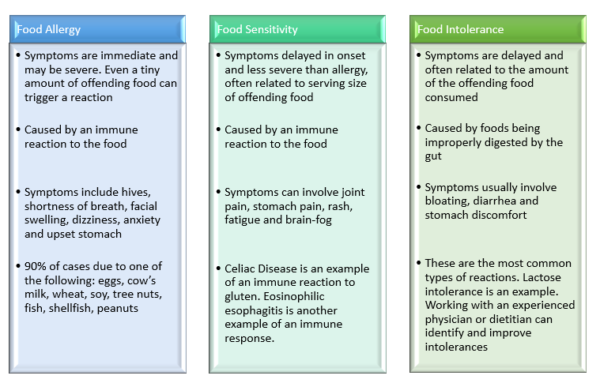In the journey toward wellness, maintaining a healthy relationship with food is crucial. Part of this involves an awareness of chronic conditions caused by overindulgence, such as diabetes, heart disease, certain types of cancer and high blood pressure.
For others, it can involve understanding why certain foods make you feel uncomfortable or ill after eating them. These uncomfortable symptoms are suggestive of three possible reactions: food allergies, sensitivities, and intolerances. These conditions can significantly affect you and your family’s quality of life, and careful navigation and intervention can reduce risks and improve overall health.
Understand the Differences: Allergy, Sensitivity, and Intolerance
To understand uncomfortable reactions a person can have with a particular food, it’s helpful to understand the way doctors and other nutritional professionals classify the reactions.
Allergic reactions involve our body’s immune system and may be triggered by even small exposure to certain foods. Allergic reactions produce a range of symptoms that can affect numerous parts of the body, such as the face and skin (hives, rash, swelling), cardiovascular, digestive, and respiratory systems. These reactions can range in severity, and some are life-threatening. For example, someone with a peanut allergy might experience a severe reaction such as anaphylaxis (swelling of the airway), requiring immediate medical attention. Estimates are that 33 million Americans have food allergies, including 5.6 million children under age 18. That’s one in 13 children, or roughly two in every classroom.[1]
Experts tell us that there are eight foods that cause about 90% of allergic reactions:
1.Eggs 4. Soy 7. Fish
2.Milk-related products 5. Peanuts 8. Shellfish
3.Wheat 6. Tree nuts*
*Tree nuts include almonds, Brazil nuts, walnuts, hazelnuts, macadamia nuts, pistachios, pecans, and cashews. Some people are allergic to just one, while some are allergic to several, or all.
Food sensitivity reactions also involve the immune system, but the symptoms are not immediate and life-threatening. Celiac Disease is an example of a food sensitivity reaction in which the body produces an immune reaction to gluten. Eosinophilic esophagitis is another condition where the immune system creates pain and symptoms after ingestion of certain foods. Health experts can diagnose and manage these conditions to prevent symptoms and chronic problems.
Food intolerances are not immune related. In contrast, food intolerances result from our body’s inability to completely digest certain foods due to problems with enzymes or buildup of unpleasant biproducts in the gut. Like sensitivity reactions, they result in primarily digestive symptoms and are not life threatening. However, food intolerance is very common and can cause significant distress. Individuals with food intolerances might experience bloating, cramps, uncomfortable gas, or diarrhea.
One common food intolerance is lactose intolerance – a condition brought on by milk and milk products. Most food intolerances are dose related – so a small amount of a certain food may be tolerated but larger portions may produce symptoms.
Management of food intolerance involves careful analysis of diet and associated symptoms, but the outcome can justify the effort. Often food intolerances can be overcome, and the offending agents may even be reintroduced to the diet with success.
Strategies for Management
Education, Awareness and Proper Diagnosis: Understanding the foods that trigger your allergies or intolerances is the first step. Read labels carefully. In the US, it’s mandatory for labels to clearly indicate common allergens like nuts, dairy, and shellfish.
For those dealing with more subtle symptoms, understanding ingredient lists can help identify potential triggers such as lactose or gluten. Proper diagnosis through medical evaluation and testing is also very helpful. For an excellent overview of food intolerance, check out the videos and articles of Dr. Will Bulsiewicz.[2]
Emergency Preparedness: Always carry necessary medications, such as antihistamines or epinephrine injectors, and wear medical identification bracelets that list your allergies. This is particularly crucial for those with life-threatening allergies, as it ensures immediate recognition of your needs in an emergency.
Communication: When dining out, effective communication with restaurant servers and chefs about your dietary needs can prevent many issues. Don’t hesitate to inquire about the ingredients in dishes and the preparation process. Most restaurants are increasingly aware of dietary restrictions and can accommodate customers with special dietary needs.
Preparation: Cooking at home allows you to control ingredients and avoid cross-contamination with allergens. For those with severe allergies, having dedicated kitchenware can be an additional safety measure.
Support Networks: Joining support groups can provide valuable tips and emotional support from others who are navigating similar challenges. These communities often share safe recipes, dining options, and other resources that can make managing dietary restrictions easier.
Navigating food reactions and intolerances does not have to be a barrier to wellbeing. With the right strategies and support, individuals can manage, and sometimes overcome, their dietary restrictions effectively and safely. By fostering awareness, preparing diligently, and embracing the journey with optimism, those affected by these conditions can have a long, healthy, and satisfying relationship with food.
Continue Reading May 2024 Newsletter: The Connection Between Stress and Blood Pressure


